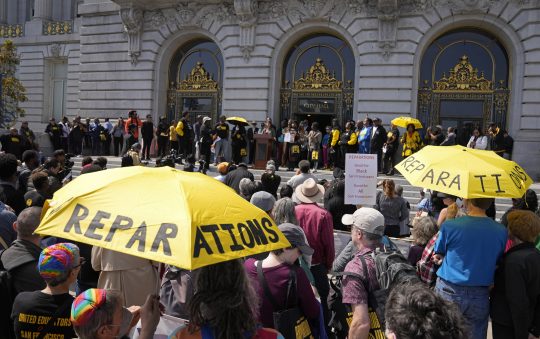
At his presentation of the 2020-21 May Revision budget, Gov. Gavin Newsom testified to the devastating impact COVID-19 has had on California’s economy. He said in a little over 100 days the coronavirus pandemic precipitated a 22.3% reduction in the state’s revenues. As a result of shelter-at-home orders issued to slow the coronavirus spread and save lives, millions of Californians have lost their jobs, schools have suspended classes and businesses have closed.
According to Newsom, the pandemic created a $54.3 billion gap between projected state revenues and expenses since his January budget presentation. In order to rebalance the budget as required by law, he employs a number of financial maneuvers, including targeted spending reductions, redirecting aid from the federal government, creating new revenue sources, instituting deferrals, and drawing from the state’s rainy-day reserve fund.
There is a possibility that funding could be restored to original budget levels if the HEROES Act, a $3 trillion stimulus bill passed by the U.S. House of Representatives, gains Senate and presidential approval.
The projected drop in revenues significantly impacted how Newsom plans to fund California’s K-12 public education system.
General funds for public education are projected to be down about $12 billion in 2020-21. About $1.6 billion in budget augmentations the governor proposed in January are rescinded. However, a $645 million increase to special education funding is being retained. The Local Control Funding Formula (LCFF), which awards state money to school districts, is cut by 10 percent or a $6.4 billion reduction. Career technical education programs are cut in half, saving $100 million, and the After School Education and Safety Program will be cut by $100 million.
To make up for the forced cuts in general fund contributions, Newsom is proposing several offsetting mitigating actions. $4 billion from the Coronavirus Relief Fund and $355 million from the Governor’s Emergency Relief Fund will be provided to school districts for learning loss mitigation. $1.6 billion is appropriated from federal Title 1 funds for school programs and another federal program will provide $714 million for child nutrition. $2.3 billion is being redirected from state funds to reduce pension contribution rates and deferred payments will be used to make about $5.4 billion available for school districts spending.
According to the Legislative Analyst’s Office (LAO), the actions taken by Newsom achieved overall school funding that is “roughly flat year-over-year.”
Acknowledging Newsom’s efforts, State Superintendent of Public Instruction Tony Thurmond said,” I want to thank Governor Newsom for working hard to prioritize and preserve public education … as we weather this economic downturn. Today’s updated budget proposal includes a variety of measures designed to avoid permanent cuts to education, which otherwise could have lasting impacts on a generation of students.”
California Teachers Association (CTA) President E. Toby Boyd said, “Governor Newsom’s leadership and commitment to safety in our public schools and colleges has been clear and much appreciated since the coronavirus surfaced in our communities 10 weeks ago.” He also says, “But the proposed education cuts for the 2020-21 budget will be devastating at a time when students need more support.”
The issues that plague K-12 education in California have only been magnified since the education budget was proposed in January. Then, Newsom expressed a clear intent to address the African American student achievement gap, to promote more diversity among teachers, and improve access to early childhood education programs.
Parents have given school districts across the state high marks for how they’ve responded to the pandemic. A statewide poll, conducted by Global Strategy Group for The Education Trust–West, finds that 81% of respondents rate school leaders’ general handling of the closures as “excellent” or “good.” But nearly 9 in 10 California parents are worried about their children falling behind academically due to coronavirus-related school closures.
The governor, state superintendent of public instruction, county superintendents, school superintendents, school boards, charter school operators, corporations, foundations and individual citizens have all joined in a monumental effort to bridge the digital divide needed to achieve student equity in participating in the distance learning programs school districts developed to take the place of classroom instruction. According to the Department of Education, student enrollment is 6.2 million students, but 450,000 students are still without computers. 345,000 are in need of access to an internet connection.
Although progress has been made in bridging the digital divide, the quick transition from classroom to online distance learning has raised concerns about students experiencing a “COVID-slide.” The term describes an educational setback students may experience when schools open in the fall. Experts predict they could return with one-third less learning gains in reading and less than 50% in math than they would have achieved in a typical school year.
“We’re kind of assuming … new materials are being offered, but new learning is not continuing at the rate it should,” according to Megan Kuhfeld of the Northwest Evaluation Association.
Assemblymember Phil Ting (D-San Francisco) has expressed concern about there being no statewide standard for distance learning programs. Ting said, “Not only is there a lack of guidelines across districts, there is a lack of guidelines within districts … If there are no guidelines … it’s like we’re going into the Wild West…”
California Department of Education (CDE) representatives responding to Ting at an education budget hearing indicated that it was up to the school districts to determine how best to deliver distance learning. When they realized it was an unacceptable response, they committed that CDE’s Loss of Learning Ad Hoc Committee co-chaired by Assemblymember Shirley Weber (D-San Diego) and E. Toby Boyd, CTA President, would be providing guidelines sometime in June.
Assemblymember Al Muratsuchi (D-Torrance) said about Newsom’s revised budget, “This is a survival budget and that we’re trying to make sure that all of our kids and all of our staff and all of our school districts are kept safe.” He went on to point out that the budget is directing a portion of the $4.4 billion for learning loss mitigation to go only to districts receiving LCFF concentration grant funds. That deprives money for needy students attending school districts not eligible for concentration grants, Muratsuchi said.
The academic performance of African American students lags behind their peers under “normal conditions.” While school districts have tried hard to make distance learning equitable, for many students it just hasn’t worked out.
The challenge the Legislature faces as it considers approving the education budget is to assure that enough funds are allocated for school districts to provide safe, effective learning opportunities for all students under current health emergency circumstances.







